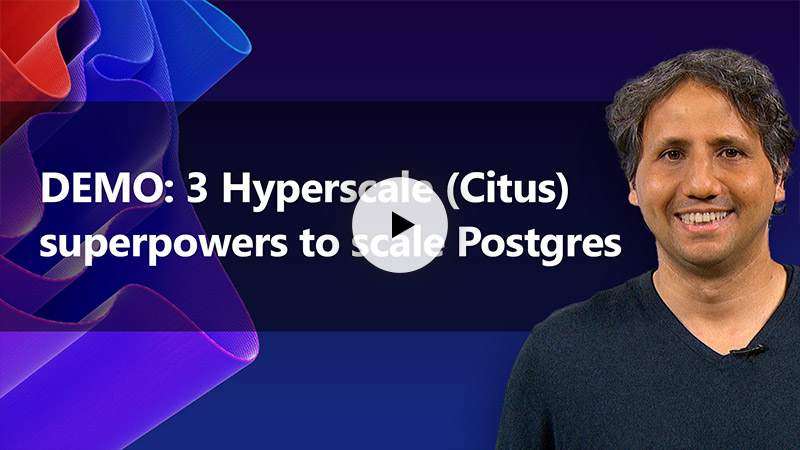POSETTE 2025 is a wrap! 🎁 Thanks for joining the fun. Missed it? Watch all 42 talks online.
This post by Nik Larin was originally published on the Azure Database for PostgreSQL Blog on Microsoft TechCommunity.
Update in October 2022: Citus has a new home on Azure! The Citus database is now available as a managed service in the cloud as Azure Cosmos DB for PostgreSQL. Azure documentation links have been updated throughout the post, to point to the new Azure docs.
There is some good news for those of you wanting to shard your Postgres database in the cloud, so that as your data grows you have an easy way to scale out your Postgres database. I’m delighted to announce that Citus 10—the latest open source release of the Citus extension to Postgres—is now generally available in Hyperscale (Citus).
Hyperscale (Citus) is a built-in option in the Azure Database for PostgreSQL managed service, which has been around for a couple of years to help those of you who would rather focus on your application—and not on spending cycles managing your database.
Newly GA features in Hyperscale (Citus) on Azure
Back in May we announced the preview of quite a few major features in Hyperscale (Citus)—including Postgres 12 and 13 support, Citus 10 with columnar compression, and read replicas to name a few. You can find all of the details are in my previous "What’s new" blog post, but here’s a quick bulleted list:
- Citus 10: learn more in Marco’s Citus 10 superpowers post
- Columnar compression: watch Jeff’s demo or read the Citus 10 Columnar post
- Foreign keys between local & reference tables: learn how this Citus feature gives you a new kind of database
- Joins between local & distributed tables: more details in this Citus tips post
- Basic tier: how why & when to shard Postgres on a single node with Basic tier
- Postgres 12 & Postgres 13: learn more about supported Postgres versions in the Azure docs [Update in Oct 2021: Postgres 14 support now available too!]
- Read scalability via read replicas: more details in the Hyperscale (Citus) docs
- Managed PgBouncer: this docs page on connection pooling explains more
Update Oct 2022: Some links have been updated to point to Azure Cosmos DB for PostgreSQL, the new home for Citus on Azure.
Current & upcoming region availability for Citus 10
Citus 10 and all the features above are now generally available in Hyperscale (Citus) in the East US, East US 2, Germany West Central, Japan East, Japan West, Korea Central, UK South, West Europe, and West US 2 regions. [Update Oct 2021: The list of regions above has been updated to reflect that Citus 10 is now available in even more Azure regions.]
This means that when you provision a new Hyperscale (Citus) server group in one of those regions, you are going to get access to all these features (and more). In the coming weeks, we will gradually roll out these new GA features in all Azure regions where Hyperscale (Citus) is available.
And if you have an existing Hyperscale (Citus) cluster: once Citus 10 and the rest of these newly GA’d features are rolled out to your region, you can expect us to plan and then update your existing server groups to give you access to the new GA features, over the course of a couple of months. We will include this update as a part of a scheduled maintenance event for your server group. Updates during scheduled maintenance are performed using failover and require a short downtime, in most cases under 60 seconds. And if you can’t wait for regular maintenance and want access to Citus 10 and the rest of these GA features sooner, we can update your server groups on demand as soon as this update reaches your region. Just ask us via e-mail.
Basic tier gives you the ability to shard Postgres on a single node
If your Postgres database doesn’t need the power of multiple nodes yet, you can select Basic tier when you first provision your Hyperscale (Citus) instance. Basic tier is what we call the new "single-node Citus" feature and it allows you to shard your Postgres tables on a single node. With Basic tier, you can be "scale-out-ready" by using a distributed data model from the start—and you can easily graduate to Standard tier and add nodes later. Or you can use Basic tier as a handy way to try out Citus.
How to get started scaling out Postgres with Hyperscale (Citus)
To figure out if Hyperscale (Citus) in Azure Database for PostgreSQL is right for you and your app, here are some ways to roll up your sleeves and try it out.
- When to use Citus: Not sure whether Hyperscale (Citus) is the right choice for your workload? Check out our guide to when to use Hyperscale (Citus)
- Try out Hyperscale (Citus): Create a server group on the Azure portal to try it out, either Basic or Standard tier. And if you don’t yet have an Azure account, just create a free Azure account
- Quickstart on Azure: If you don’t have a distributed dataset to play with, you can start with this step-by-step guide
- Tutorials: Try the tutorials for multi-tenant SaaS and real-time analytics dashboards
- Docs: Read the Hyperscale (Citus) docs on distributed data concepts, determining application type, or selecting the initial cluster size
- Video: Watch this 5 min demo from my boss Umur Cubukcu about Hyperscale (Citus), showcasing some of the new things in Citus 10, including columnar compression and Basic tier
Update Oct 2022: Some links have been updated to point to Azure Cosmos DB for PostgreSQL, the new home for Citus on Azure.

